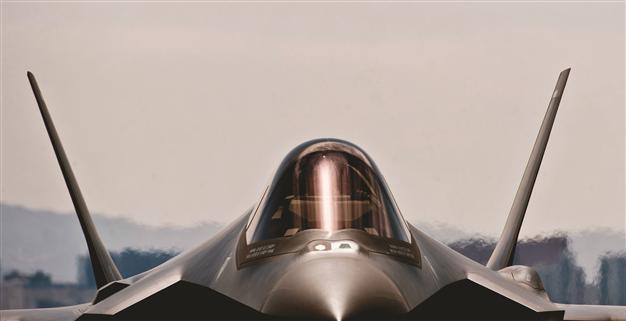US to advance target date for F-35 use
WASHINGTON - Reuters

The US Air Force plans to start operational use of F-35, using a less capable software package that will carry fewer weapons at first although thesoftware will later be upgraded to the final version. REUTERS photo
The U.S. Air Force plans to start operational use of Lockheed Martin Corp.-built (LMT.N) F-35 fighter jets in mid-2016, a year earlier than planned, using a similar software package as the Marine Corps, according to two sources familiar with the plans.
The Air Force’s decision to accelerate its introduction with a slightly less capable version of the F-35 software package means the planes will carry fewer weapons at first, although the software will later be upgraded to the final version, said the sources on May 20, who were not authorized to speak publicly.
Air Force spokeswoman Ann Stefanek said a final decision had not been made and declined to comment further. A spokesman for the Pentagon’s F-35 program office declined to comment.
The decision reflects the military’s desire to start using the new warplanes, which are already rolling off the assembly line at Lockheed’s sprawling Fort Worth, Texas, plant, even as military officials continue to test the plane.
“This decision gets that (U.S.) fifth-generation capability out on the front lines that much sooner,” said one of the sources familiar with the Air Force’s plans. “It also sends a message about confidence in the program to Congress and the international partners.”
‘It’s about changing order of battle’Former Air Force Secretary Michael Wynne said accelerating operational use of the new warplane would allow the Air Force to learn more about the F-35’s integrated battle management system.
“This is not just about replacing aging F-15’s or F-16’s; it is about changing the order of battle and truly embracing a integrated form of warfare where the F-35 manages the targeting and directs supporting fire at the same time as providing more precise aim points,” Wynne told Reuters in an email.
The Air Force, Marines and Navy must report to Congress by June 1 on their target dates for initial operational capability, or IOC, which marks the point when the services have enough planes on hand to go to war if needed. Actual deployments usually lag IOC dates by about a year.
The sources said the services would send Congress a list of target or “objective” dates for declaring initial operational capability and a list of “threshold” dates, or deadlines.
The Marines Corps is sticking to its plan to begin early operational use in mid-2015 of its F-35B jets, which can take off and land like a helicopter. It will be the first of the three U.S. military services to start using the jets.
The Navy has set mid-2018 for starting operational use of its C-model F-35, which is designed for use aboard U.S. aircraft carriers. Its deadline or threshold date is early 2019. The Air Force decision marks a reversal from its earlier insistence that it needed the final 3F software package and comes after a Pentagon report cited China’s development of two new fifth generation fighters over the past year.
The Air Force will have
about 100 F-35s by 2016, when it plans to declare the planes ready for operational use.
Turkey one of F-35 partnersTurkey is one of nine countries that are part of a U.S.-led consortium to build the F-35 fighter. The others are Britain, Canada, Italy, the Netherlands, Australia, Norway and Denmark.
Turkey had planned to order 100 units of the stealth fighter to replace its current fleet, consisting mainly of F-4 Phantoms and F-16 Falcons, but it postponed in January the order to purchase its first two U.S.-made F-35 fighter jets due to technical problems and rising costs, but said it still intends to buy 100 more in the long run.
